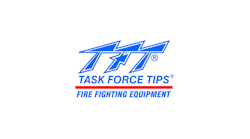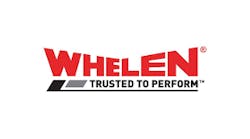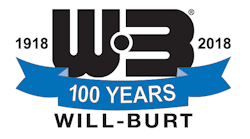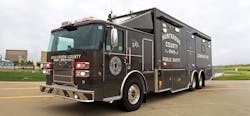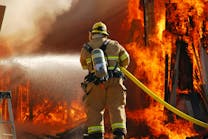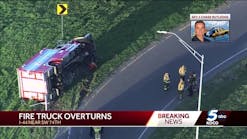There are many areas of the country where innovative pieces of apparatus can be found. Some of these vehicles are older, used units which were acquired and then heavily modified to meet local conditions and budget requirements. Others are brand new rigs which represent the latest in technology and safety and typically are larger and heavier in size than their earlier counterparts. Whether old or new, well-designed engine company apparatus should be set up to provide safety for the crew as well as provide a good accounting of itself on the fireground by carrying a number of pre-connected attack lines and appliances to develop the needed fire flow at incidents.
Our "Innovative Rigs on the Street" series started last year with a review of an engine company in Carlisle, PA in Cumberland County. A little farther to the west of Carlisle lays the Upper Frankford Fire Company which operates as Company 48 in Cumberland County. This fire company was organized in February, 1950 and originally operated with a used Dodge pumper that had been modified to carry a 350-gallon water tank for rural water supply. In later years the department acquired a 1967 American LaFrance 750-gpm pumper from Carlisle and rebuilt the apparatus by adding a Harrisburg Blitz Box which provided the unit with five crosslay hose beds. By the early 1980's the station was operating with a 1982 Ford/FMC pumper, a department built tanker on a 1975 Ford chassis and a classic 1952 Dodge brush unit that had been acquired thru the Pennsylvania Bureau of Forestry.
Today the Upper Frankford Fire Company is under the command of Chief James Salisbury II and protects all of Upper Frankford Township in addition to areas of Lower Mifflin, North Newton, Penn Township and West Pennsboro Township where the fire company responds in conjunction with the box alarm system utilized in Cumberland County. The department's current fleet of apparatus includes Engine 148, a 2008 KME Predator Challenger pumper, Engine 248 a Spartan Gladiator Four Guys engine-tanker equipped with a 1750-gpm pump and a 2000-gallon water tank and Brush 48, a 2000 Ford F-350 chassis equipped with a utility body carrying a Darley 150-gallon skid unit. Support units include a Chevy Suburban which is outfitted as an EMS first response unit and a 2009 Ford F-250 pick up which is utilized as a traffic control unit.
The newest apparatus, Engine 148, was designed by the members of the department's truck committee working closely with the local KME representative Lo Barrick. This unit has some unique features including a stainless steel body with a full-width hose bed that incorporates enclosed tunnel storage for both ground ladders and hard suction hose with over 260 cubic feet of enclosed compartment storage space. The apparatus is built on a 192-inch wheelbase with an overall length of 31 feet, 11 inches. The full-width hose bed design allowed for the unit to carry a wide assortment of attack lines, generator and light tower while maintaining an overall height of just 111 inches.
In And Around The Cab
The apparatus is powered by a Caterpillar model C-9 engine rated at 425-horsepower using a Caterpillar model CX-28 five-speed transmission. The front axle is rated for 21,400 pounds with the rear axle rated at 31,000 pounds. The Predator medium extended cab provides seating for six personnel with five seats equipped with secured SCBA brackets for the protection of the crew. The 12-inch raised roof provides approximately 65.50 inches of interior headroom height with an overall cab width of 96 inches.
The front bumper is equipped with a 5-inch front suction with a swivel as well as a 2-inch front trashline that carries 150 feet of 1-inch forestry hose in an enclosed aluminum tread plate compartment. In order to provide sufficient room for these components as well as the Federal Q-2B siren, air horns and electronic siren speaker, a 20-inch bumper extension was required.
The apparatus warning light package consists of a Whelen 72-inch wide LED light bar on the cab roof together with both 600 series and 900 series Whelen LED lights along the upper and lower portions of the cab and body. Twelve-volt scene lighting is provided on both sides of the upper body and at the rear with switch controls inside of the cab. A Whelen LED traffic advisor is recess-mounted at the rear body in addition to an ASA Voyager back-up camera. A Harrison 15-Kw hydraulic generator is located in the recessed area over the fire pump and supplies power to a Hannay cable reel equipped with 200 feet of 10/4 cable and three body outlets. The cab is provided with a Fire Research 1000-watt Focus brow light together with two 1500-watt telescopic lights at the rear of the cab. The rear of the body carries two portable 500-watt tripod telescopic lights which can be utilized both on and off of the apparatus as required. A Wilburt model NS10-6000 light tower is recess-mounted at the front of the apparatus body ahead of the hose bed which allowed space for the water and foam fill towers and hose bed piping without disturbing the hose bed layout.
Firefighting Features
The firefighting capability Engine 148 is provided by a Hale Q-Max single-stage pump rated at 1750-gpm which is enhanced by a Foam Pro 1600 series foam system which can supply Class A foam to the front trash line, two of the crosslays and the rear 2-inch attack line. Each of the three crosslays are equipped with 150 feet to 200 feet of 1 3/4-inch hose with a feature that the discharge for each of the attack lines is located immediately below the crosslay opening. Each of the pre-connected hoselines are color coded both on the pump panel on the gauge and the controlling gate, as well as the hoseline itself to minimize confusion on the fireground for the pump operator. The apparatus is equipped with two hose bed discharges to supply a 300-foot 2-inch attack line as well as a 300-foot 3-inch line for a Task Force Blitz Fire tailboard gun. As the apparatus is provided with a total of six pre-connected attack lines, the importance of a 1,000-gallon water tank with a 20-gallon Class A foam cell is readily apparent during rural water supply operations.
The rear, full-width hose bed also carries 1,400 feet of 5-inch supply line and 400 feet of 3-inch hose which can be used as a leader line to extend the pre-connected lines and for tanker refill lines when the engine is utilized as a fill site pumper. The engine has the capability of taking suction from both sides as well as the front intake using Hale master intake valves which are equipped with a manual override. Engine 148 is equipped with a Task Force Hurricane remote control deck gun which is fed by a 3-inch discharge from the pump. The tank to pump line is a 4-inch line with an air operated 4-inch full flow valve which can supply adequate water to any of the pre-connected attack lines as well as the tailboard gun.
The stainless steel body is equipped with seven enclosed body compartments utilizing a mixture of adjustable shelves, trays, tool boards and pull-out, drop-down trays to accommodate all of the tools and appliances. All of the tool mounting and labeling on this unit was accomplished by department members and is an outstanding example of what can be done when utilizing the talent within the fire company. The compartments on Engine 148 are very well laid out and designed, particularly the mounting of the individual adapters, fittings and hand tools in the left side forward compartment. In addition to the normal engine company compliment of equipment, the unit carries twin Amkus hydraulic hose reels together with a spreader, cutters and shoring material for vehicle extrication.
For many years we considered rural fire apparatus to be limited in fire attack capability. Upper Frankford Engine 148 is a fine example of a well thought out piece of apparatus with full compliment of attack lines, supply hose, tools and equipment to safely carry out any mission that might be assigned to the unit.
I would like to thank Chief Jim Salisbury II and the members of the Upper Frankford Fire Company who assisted with technical information and photographs of their apparatus. A special thank you to Jason Witmier of KME Fire Apparatus for his assistance.
TOM SHAND is a 37-year veteran of the fire service having served with departments in Maryland, Pennsylvania and New York. He has worked in the fire apparatus industry since 1985, including 15 years with Saulsbury Fire Apparatus. He is a contributing editor to Fire Apparatus Journal and Firehouse Magazine and works with Mike Wilbur at Emergency Vehicle Response. He co-hosts the Apparatus Architects podcast with Wilbur, based on their column in Firehouse Magazine.

